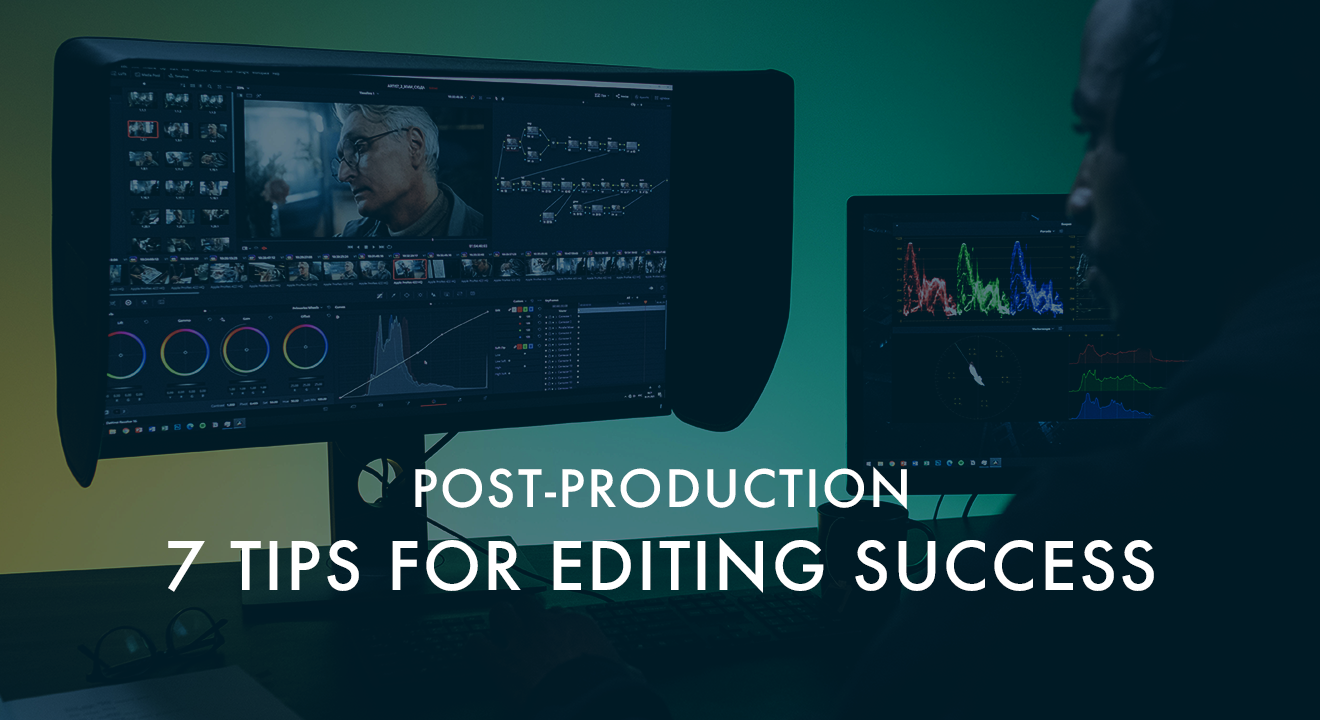As a filmmaker, marketing guru, or video enthusiast, you understand the important role that video editing plays in shaping your final masterpiece. Whether you’re working on a narrative film, a documentary, or a corporate video, the post-production phase is where the awesomeness truly happens. Post-production can also be where you overspend your budget and wreak havoc on your peace of mind. To ensure the latter doesn’t occur, we’ve compiled seven tips to help you prepare for post-production success.
Before we begin, it’s always worth noting that if you go into the editing process without a clear plan, you better have a big wallet. Editing charges can surge if you’re not careful. If you’re the one editing, you can also waste a tremendous amount of time trying to figure things out. And the last time I checked, time is money!
Let’s begin!
Post-production starts with Organization:
If you are editing your project, one of the first things you need to do is organize. Before you even think about importing your media into the editing software, take the time to manage your footage meticulously. Create a folder and naming structure that makes sense for your project, and label your files clearly. This initial step will save you countless hours of frustration when you’re searching for that perfect shot. In some cases, you can add notes and tags to media to help you find clips faster without wasting time searching for them.
Craft a Clear Editing Plan:
This tip is a biggie for clients who may be hiring an editing company to help them produce a project. Often, edit plans can save upwards of 70% of your time in post-production. This is why it is critical to map out a detailed editing plan before you or your editor start cutting clips together. Consider the pacing, storyline, and overall flow of your video. A clear vision of your goal will also help you manage expectations and produce a better product.
Select the Right Editing Software:
If you are a first-time editor, this tip is specifically for you. Choosing the right editing software that suits your skill level is essential. Although most editing software such as Final Cut Pro X, Adobe Premiere, and DeVinci Resolve offer an easy-to-use platform, you may be inclined to start with more basic editors such as iMovie or Adobe Rush. The editing program will also be reflected in the type of media that you are working with. So, for example, if you shot your movie with a Blackmagic Pocket Cine, you may be better suited to use a program like DeVinci since that program was designed for that specific camera system. Regardless of anything, make sure you’re comfortable with the tools at your disposal. Familiarize yourself with the software’s features and shortcuts to work efficiently.
Focus on Post-production Audio Quality:
Don’t overlook the importance of audio in post-production. Poor audio can ruin an otherwise great video. Invest in quality microphones and audio recording equipment, and pay close attention to sound mixing and editing. Clean and crisp audio will elevate the overall production value of your video. Bad audio will negatively impact you as a service provider. If you’re editing media provided to you by someone else, be sure to have conversations early on (if possible) with the production team to ensure they can capture good sound. Remember, you can only do so much in posts regarding lousy sound recording.
Experiment with Different Post-Production Techniques:
The editing phase is perfect for unleashing your creativity and experimenting with different editing techniques. I am a big fan of YouTube and will spend some time looking at other editing styles that could be appropriate for what I’m working on. The big thing to always remember is that not all projects are created equal, nor should they be. Some editing projects require slower, more traditional transitions, pacing, and visual storytelling cues. Some video edits, especially for marketing purposes, call for faster-paced cuts, graphics, and narrative structures. Be sure to understand the difference and edit accordingly. A good editor is typically one who is only good at one thing. However, a masterful editor is one who can adapt and change with a project.
Seek Feedback and Collaboration:
Don’t be afraid to seek feedback from others during the editing process. This can open up a Pandora’s box of revisions for you, but the thing to understand is that edits sometimes need fresh perspectives. When you’ve been sitting with an edit for an extended period, you can often be blinded by your own tunnel vision. This is why bringing others in early on can help you see things that may otherwise be overlooked. Collaborate with your clients, other filmmaking and video colleagues, friends, or mentors to gain fresh perspectives on your work. Constructive criticism can help you identify areas for improvement and refine your editing skills.
It’s Coffee Time! Take Breaks and Rest:
Remember to take breaks and give yourself time to rest during the editing process. I typically reward myself with a cup of coffee or tea throughout my day. Walking away from your edit station is good for the creative process and your health. Staring at a screen for hours can lead to fatigue and decreased productivity. Step periodically from your computer, walk, or engage in other activities to recharge.
As I leave you, I hope these tips on post-production serve as a guide to help you get the most out of the process. Making any type of video or film requires a good perspective on the editing process, so allow yourself some grace as you enter this exciting phase. Thank you for reading, and hope to have you back soon!
Kelly, Indie Film Factory
Are you looking for post-production on your next project? Contact Indie Film Factory to see if we could be a good fit.



